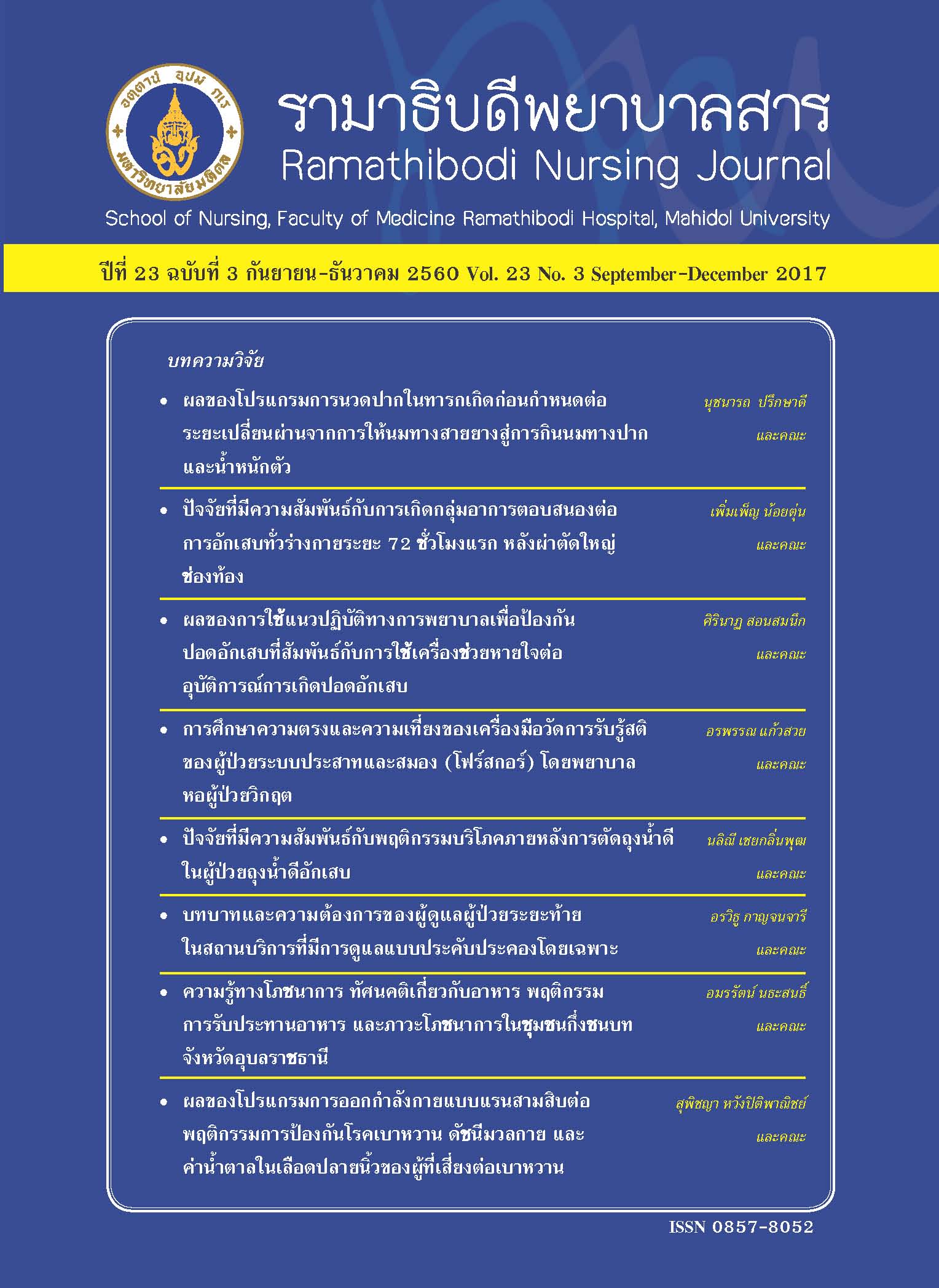การศึกษาความตรงและความเที่ยงของเครื่องมือวัดการรับรู้สติของผู้ป่วยระบบประสาทและสมอง(โฟร์สกอร์)โดยพยาบาลหอผู้ป่วยวิกฤต
Main Article Content
บทคัดย่อ
This study aimed to investigate the properties of the tools used to assess the level of consciousness of patients with neurological diseases. The sample consisted of 26 critical care nurses with two or more of year experiences and 66 patients with neurological diseases admitted to the surgical intensive care ward. For the study method, neurosurgeons assessed patients with the Glasgow Coma Scale (GCS) and the Full Outline
of Unresponsiveness (FOUR) Score and then, nurses assessed patients with the GCS and the FOUR Score in the same patients by a period of no more than 30 minutes each time. Using the FOUR Score, as compared to using the GCS, to assess the consciousness in patients with neurological diseases, the criterion related validity was found to be high. In addition, the criterion related validity of various levels of consciousness (alert, drowsiness, stuporous, and comatose) with the FOUR Score, as compared to the GCS, in patients with neurological diseases were found as moderate to very good levels. The inter–rater reliability coefficients between neurosurgeons and nurses with more than 5 years working experiences and with 2-5 years working experiences were found as very good and good, respectively. When each component was analyzed, it found that in the FOUR Score, the inter–rater reliability coefficient of the movement component was
lowest, while in the GCS that of the speech component was lowest. In conclusion, the FOUR Score was regarded as a valid and reliable assessment tool of level of consciousness. However, nurses with less working experiences need training before using this assessment.
Article Details
บทความ ข้อมูล เนื้อหา รูปภาพ ฯลฯ ที่ได้รับการตีพิมพ์ในรามาธิบดีพยาบาลสาร ถือเป็นลิขสิทธิ์ของวารสาร หากบุคคลหรือหน่วยงานใดต้องการนำทั้งหมดหรือส่วนหนึ่งส่วนใดไปเผยแพร่หรือเพื่อกระทำการใด ใด จะต้องได้รับอนุญาตเป็นลายลักษณ์อักษรจากรามาธิบดีพยาบาลสารก่อนเท่านั้น
เอกสารอ้างอิง
2. Kusum V. Critical carenursing: a holistic approach, 4thed. Bangkok: Sahaprachapanich; 2010. (in Thai)
3. Cohen J. Interrater reliability and predictive validity of the FOUR score coma scale in a pediatric population. J Neurosci nurs 2009;41:261–7.
4. Wijdicks EF, William RB, Boby VM, Edward MM, Robyn LM. Validation of a new coma scale: the FOUR Score. Annals of Neurology. 2005;58:585-93.
5. Stead LG, Wijdicks EF, Bhagra A, Kashyap R, Nash DL, Enduri S, et al. Validation of a new coma scale, the FOUR Score, in the emergency department. Neurocrit Care. 2009;10:50-4.
6. Jennett B. The Glasgow Coma Scale: history and current practice. Trauma. 2002,4:91–103.
7. Shoqirat N. Nursing students’ understanding of the Glasgow coma scale. Nurs Stand. 2006;20:41-7.
8. Teasdale G, Jennett B. Assessment of coma and impaired consciousness. The lancet. July 1974;13:81–3.
9. Teasdale G, Jennett B. Assessment and prognosis of coma after head injury. Acta Neurochir (Wien). 1976;34:45-55.
10. Georgios M, Theodossios B. The Glasgow Coma Scale – a brief review past present future. Acta Neurol. 2008;108: 75–89.
11. Silvitasari I, Purnomo HD, Sujianto U. Sensitivity and specificity of Full Outline of Unresponsiveness Score and Glasgow Coma Scale towards patient’s outcomes at the intensive care units. JOSR-JNHS. 2017;6(1):10-3.
12. Iyek VN, Mandrekar JN, Danielson RD, Zubkov AY, Elmer JL, Wijdicks EF. Validity of the FOUR Score coma scale in the medical intensive care unit. Mayo Clin Proc. 2009; 84(8):694-701.
13. Chen B, Grothe C, Schaller K. Validation of a new neurological score (FOUR Score) in the assessment of neurosurgical patients with severely impaired consciousness. Acta Neurochir. 2013;155:2133–9.
14. Juan P, Yingying D, Fangyao C, Xiaomei Z, Ying Z, Hongzhen Z, et.al. Validation of the Chinese version of the FOUR score in the assessment of neurosurgical patients with different level of consciousness. BMC Neurology. 2015;15:254-60.
15. Weiss N, Mutlu G, Essardy F, Nacabal C, Sauves C, Bally C, et al. The French version of the FOUR score: a new coma score. Revue Neurol (Paris). 2009;65:796-802.
16. Wolf CA, Wijdicks EF, Bamlet WR, Mccleland RL. Further Validation of the FOUR Score coma scale by intensive care nurses. Mayo Clinic Proceedings. 2007; 82:435-8.
17. Metheesiriwat N, Kuptniratsaikul S. The FOUR score and Glasgow coma scale to evaluate the patiens with intubation at emergency room. Royal Thai Army Medical Journal. 2012;65:145-52. (in Thai)
18. Srisatidnarakul B. The methodology in nursing research. 4thed. Bangkok: You and I Intermedia; 2005. (in Thai)
19. Naipat A. Quantitative and qualitative research methodologies in behavioral and social science. Bangkok: Srinakarinwirot University; 2005. (in Thai)
20. Anita MS, Ramesh T, Sandhya Y, Hemant. Can FOUR Score replace GCS for assessing neurological status of critically ill patients - an indian study. Nursing and Midwifery Research Journal. 2013;9:63-72.
21. Royal College of Surgeons in Ireland; 2016 [cited 2016 June 08] Ronan MC, The RCSI sample size handbook Available from: http://rcsi.ie/files/research/docs/ 201608 11111051_Sample%20size%202016.pdf
22. Ruth S. FOUR Score challenges Glasgow Coma Scale. Emergency Medicine News. 2006;28(8):50-1.
23. Fischer J, Mathieson C. The history of the Glasgow Coma Scale: implications for practice. Crit Care Nurs Q. 2001; 23:52-8.
24. Deeying S, Kanogsunthornrat N. Quarity of (FOUR) Score: a literature review. [thesis]. Nakhon Pathom: Mahidol University; 2014. (in Thai)


